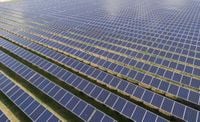In a year that’s already being called a turning point for the world’s energy future, a cascade of breakthroughs is reshaping how humanity powers itself—from the sunlit rooftops of India to the stormy Atlantic off the Canary Islands. The first half of 2025 has seen renewable energy sources, especially solar and wind, outpace coal for the first time in recorded history, according to a recent report cited by weather.com. This shift is not just a statistical footnote; it’s a signal that the global energy system is finally tilting toward a cleaner, more sustainable path.
The numbers tell a compelling story. Between January and June 2025, global electricity demand rose by 2.6%. Yet, instead of being met by fossil fuels as in years past, this entire increase—and then some—was supplied by surging renewable generation. Solar and wind alone added a staggering 403 terawatt-hours (TWh) of new power, with solar accounting for an astonishing 31% growth in just six months. In total, renewables generated 5,072 TWh, surpassing coal’s 4,896 TWh. For the first time, the world’s appetite for electricity is being fed more by the sun and wind than by the black rock that powered the industrial age.
“We are seeing the first signs of a crucial turning point. Solar and wind are now growing fast enough to meet the world’s growing appetite for electricity,” said Małgorzata Wiatros-Motyka, Senior Electricity Analyst at Ember, as reported by weather.com. She added, “This marks the beginning of a shift where clean power is keeping pace with demand growth.”
Solar power, once seen as a niche or even a luxury, is now the fastest-growing form of electricity generation worldwide. According to the Global Solar Council, solar now makes up 8.8% of global electricity—up from 6.9% just a year ago. China led the charge, accounting for 55% of global solar growth, with the United States, European Union, India, and Brazil following close behind. “This analysis confirms what we are witnessing on the ground: solar and wind are no longer marginal technologies, they are driving the global power system forward,” said Sonia Dunlop, CEO of the Global Solar Council.
Coal, meanwhile, is beginning to lose its grip. Global coal generation fell slightly—by about 0.6%—with notable declines in both China and India. In China, the drop is described as more "structural," hinting at a longer-term shift away from coal. Even as global electricity demand grew, emissions from the power sector actually fell slightly in the first half of 2025, thanks to these clean energy gains. Drops in emissions from China and India offset increases in the U.S. and EU, where fossil fuel use ticked up to compensate for weaker wind and hydro generation.
But the story of renewable energy’s rise isn’t just about statistics or global trends. It’s also about innovation and ambition at the local level. Take the British firm Global OTEC, for instance. On October 27, 2025, the company installed a prototype ocean thermal energy conversion (OTEC) power module off the coast of Gran Canaria in the Spanish Canary Islands. The aim? To test the resilience of a technology that could convert the vast solar heat stored in the oceans into renewable baseload power—power that’s available day and night, rain or shine.
The prototype, affectionately nicknamed Don in honor of Don Lennard, a British aircraft engineer and Royal Navy veteran who dedicated his life to advancing OTEC technology, is now stationed at the Oceanic Platform of the Canary Islands (PLOCAN) test site. This isn’t the first time OTEC has been tried, but it’s the first major test in decades. The technology works by using warm surface seawater to evaporate a working fluid with a low boiling point. The resulting vapor spins a turbine to generate electricity, while cold deep water cools the vapor back into a liquid, ready to be reused in a continuous cycle.
According to Global OTEC, this cycle can run around the clock, offering a much-needed source of clean baseload power for tropical island nations that still rely heavily on diesel generators. “This is more than just a test of the core technology, which has already been proven to work—it’s a demonstration of resilience,” said Dan Grech, founder and CEO of Global OTEC. “If we can demonstrate that OTEC platforms can operate safely and continuously through extreme weather, we open a new chapter for clean baseload power in regions that need it most.”
The platform’s cylindrical hull has already been deployed, with the next step being the installation and connection of a cold water pipe. Full structural testing will soon commence, subjecting the unit to the rough conditions of the Atlantic Ocean, including simulated hurricane-level storms. “The data collected during the tests will validate our computational models and show how accurately we can simulate the interaction between the large-diameter riser and the vessel under a range of conditions,” said Sam Johnston, lead engineer at Global OTEC.
Meanwhile, in India, the renewable revolution is gathering steam in a different way. On October 27, 2025, Waaree Energies, one of India’s leading solar module manufacturers, announced a major new order for 122 megawatts (MW) of solar modules. The deal, though its total value wasn’t disclosed, represents a significant boost to India’s clean energy deployment targets and supports the country’s National Solar Mission and broader net-zero commitments.
Waaree Energies is rapidly expanding its manufacturing capacity to meet growing demand across commercial, industrial, and utility-scale sectors. As industry experts point out, such large-scale orders underscore the importance of domestic solar manufacturing in achieving India’s sustainability objectives. The company’s growth is not just good for business—it’s helping India transition to a sustainable, low-carbon energy infrastructure.
“By expanding its supply of high-efficiency modules, Waaree Energies is not only strengthening its business outlook but also supporting the decarbonization of India’s power sector,” industry analysts have noted. The company’s consistent expansion in manufacturing capacity and market presence positions it as a key driver in enabling India’s sustainable and low-carbon future.
All these developments—global, regional, and technological—are converging at a moment when the world’s energy choices matter more than ever. As Małgorzata Wiatros-Motyka of Ember put it, “As costs of technologies continue to fall, now is the perfect moment to embrace the economic, social and health benefits that come with increased solar, wind and batteries.”
If the current pace continues, 2025 may be remembered as the year the global power shift truly took off. From the windswept Canary Islands to the bustling factories of India and the vast solar arrays of China, the world is finally beginning to harness the forces of nature to light its future—cleanly, reliably, and for everyone.

